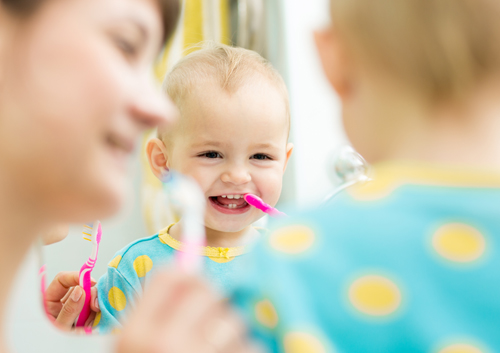
As a parent, it is your job to instill good dental habits in your kids, and this starts even earlier than you might realize. The American Academy of Pediatric Dentistry responds to the “when to start” question with a succinct “The sooner the better!”
From the time your baby is born, you should make sure that your child’s gums are regularly cleaned using water and a toothbrush made for infants. Once the first tooth erupts, you should visit the pediatric dentist for the first time. Dr. Iyer and our staff often recommend that if your child is a year old, but has yet to get the first tooth, you should bring your son or daughter to our Wichita Falls, TX office for his or her initial dental care appointment.
Once your child’s teeth start to appear, you can begin brushing two times per day, using fluoride toothpaste. Choose a toothbrush made specifically for your child’s age group, and one with has soft bristles.
Only a small smear of toothpaste is needed if your child is under two years old. Once the child celebrates his or her second birthday, you can use a pea-sized amount of fluoridated toothpaste. Continue this practice until your child is five.
Of course, it is important that you monitor your child’s tooth brushing closely to help educate about proper techniques. Some young children might try to eat or swallow toothpaste, and this needs to be strongly discouraged. Be sure to teach proper rinsing and spitting behavior to round out your child’s early childhood tooth-care regimen.
For young kids, tooth brushing can be made into a fun event, and you can find a multitude of special toothbrushes that appeal to kids. There are even uniquely flavored and colored toothpastes that might encourage your child to get into the brushing game!

Earth Day began in 1970 as an event to raise awareness of our environment. What began as a single day in April is now recognized around the world to bring attention and education to global environmental issues. Conserving our natural resources, reducing water and air pollution, and developing green technologies are all ways in which we can improve the environment around us.
Reduce, Recycle, and Reuse
One of the easiest ways to participate in Earth Day is by simply reducing the amount of refuse that ends up in landfills. Many communities have recycling programs for paper, plastic, and metal refuse. By keeping recyclable items out of landfills, we reduce the need for new disposal space and the amount of energy needed for burning refuse. Recycling products also helps conserve the resources that are used in making new products.
You can save money by reducing your consumption of many everyday products. Single disposable water bottles can be recycled but they are costly. By using filtered faucet water, you can conserve your financial resources. Disposable paper towels can also be wasteful. Consider reusable cleaning rags for the majority of your chores.
Reusing items saves both the environment and your finances. A large number of products can be re-purposed to create a new item. Old furniture can be remade into a new piece. Old clothing can be used for craft items. If you are not able to find ways to reuse your old items, donate them to a charity. Remember to continue your positive environmental steps on a daily basis.
Other things you can do to improve the environment
Everyone, young or old, can find ways to participate in improving the environment. Some ideas include:
Earth Day is designed to appreciate and celebrate the health of the earth. Keeping the earth healthy is important, but keeping your mouth healthy is important, too. Healthy teeth and gums contribute to your overall health and well-being, so remember to call our team at Dentistry 4 Kidz to schedule an appointment. Have a happy and healthy Earth Day, from Dr. Iyer!

Have you ever watched to see if your child is breathing through his or her mouth? Breathing through the mouth instead of the nose may lead to trouble for youngsters. Kids who typically breathe through their mouth—most often children who suffer from allergies—experience problems getting enough oxygen into their blood, a condition that affects their weight, size, sleep, and even their performance in the classroom and daily life.
Mouth breathing as a child can also lead to sleep apnea, behavior and learning problems, delayed speech, dental and facial abnormalities, and even breathing problems as your child grows. There are a multitude of reasons for an individual to mouth breathe, such as enlarged tonsils, adenoids, and deviated nasal septum, but the cause is usually allergies.
As bad as the condition sounds, we want you to know mouth breathing is a treatable condition. Doing so, though, requires early diagnosis and treatment. Since our team at Dentistry 4 Kidz sees our patients every six months, we may be in a position to identify the symptoms of mouth breathing.
If you suspect your child is a chronic mouth breather, please give us a call at our convenient Wichita Falls, TX office to schedule an appointment with Dr. Iyer.

Dental sealants are an excellent way to protect children’s teeth from tooth decay by coating them with a thin plastic material. Their teeth look and feel like normal, but they are protected from plaque build-up and decay early on. Dr. Iyer and our staff recommend sealants as a preventive measure for children before any decay appears on their teeth.
Who should get dental sealants?
Dental sealants are intended for young children as soon as their first teeth come in. Decay is most common in the molars, so taking your child to Dentistry 4 Kidz for sealants right when you see the molars grow in gives your child the best chance to fight tooth decay.
A child’s first set of permanent molars grow in between ages five and seven, while the second permanent molars come in between 11 and 14 years of age. Some teens and adults who don’t have tooth decay may get sealants as well, but it is less common.
How long do dental sealants last?
Once the sealant has been placed on the teeth, it lasts up to ten years. Expect to have Dr. Iyer check the sealant at every visit to our Wichita Falls, TX office, which should be twice a year. We will look at the sealant and determine if it needs to be replaced.
What is the process of getting sealants?
Applying sealants is a simple, pain-free procedure that is done quickly at Dentistry 4 Kidz. There is absolutely no effect on the tooth structure from sealants.
For starters, the teeth are cleaned carefully, then dried with an absorbent material. A mild acid solution is applied to them to roughen them slightly. This is done so the sealant can bond properly to the teeth. Then the teeth are rinsed and dried, and the sealant material is painted on and dried with a special light.
Molars are susceptible to decay early on, which is why sealants are an important treatment to get for your children’s first set of teeth.